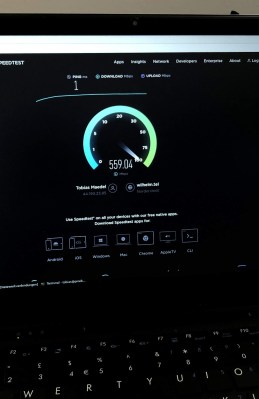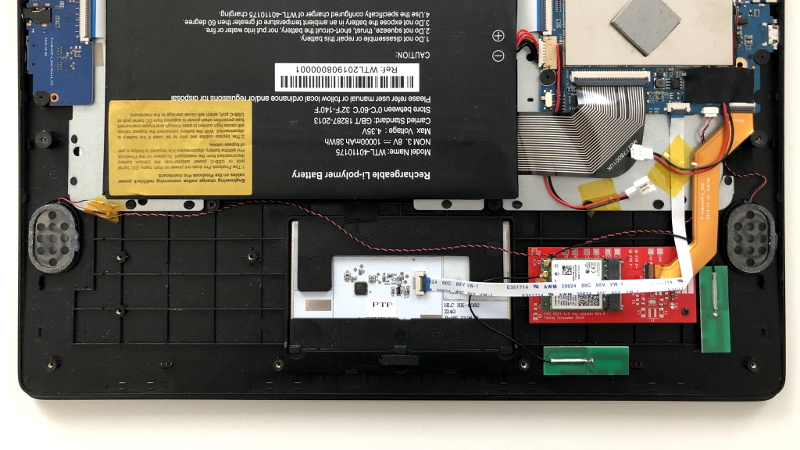The Pinebook Pro is a considerably more capable machine than the $99 Pinebook released in 2017, but the open source laptop still isn’t exactly a powerhouse by modern standards. The system is intended to compete with mid-range Chromebooks, and to that end, few would argue it’s not worth the $199 price tag. But there’s still room for improvement, and at this price point that makes it a hardware hacker’s delight.
 [TobleMiner] has recently released the design files for a drop-in adapter that allows you to install M.2 wireless cards like the Intel AX200 in the Pinebook Pro. With the latest-and-greatest WiFi 6 technology onboard, transfer rates as high as 600 Mbps have been demonstrated on this relatively low-cost Linux laptop. It sounds like there’s a possibility the adapter will be offered officially through the Pine store at some point in the future, but in the meantime, you can always spin up your own copy if you feel the need for speed on your Pinebook Pro.
[TobleMiner] has recently released the design files for a drop-in adapter that allows you to install M.2 wireless cards like the Intel AX200 in the Pinebook Pro. With the latest-and-greatest WiFi 6 technology onboard, transfer rates as high as 600 Mbps have been demonstrated on this relatively low-cost Linux laptop. It sounds like there’s a possibility the adapter will be offered officially through the Pine store at some point in the future, but in the meantime, you can always spin up your own copy if you feel the need for speed on your Pinebook Pro.
The adapter takes the place of the official M.2 SSD upgrade board, which means users will need to choose between expanded storage and an upgraded wireless card. But [TobleMiner] hints that a version of the adapter with a second M.2 slot should be possible in the future. The design also features pads to install an optional voltage regulator, as testing has shown that the Pinebook Pro’s 3.3 V line can fluctuate a bit depending on battery level.
We took a close look at the original Pinebook when it was released, and came away cautiously optimistic. The Pro model appears to be an improvement in every way imaginable, and upgrades like this show just what’s possible when users are free to explore their hardware.















It never ceases to amaze me when people demand open source products and when a company releases one the screams of oh but we only want to pay the same price of the closed source mega company products.
I struggle to see much point in doing that, unless you want to boot off wifi. Fast network, slow storage. I didn’t really see much use for gigabit home networks until we were into the SATA era. Maybe it’s to sell to my “buddy” who has had 5 down 1 up ADSL since 2005, but buys a new router for every new wifi standard, and of late, it has to have more sticky up bits pretending to be antennas than the last one. Every time it’s “Whoa dude, my internet is sooooooo much faster now!!!”
I’ve had a chromebook with really really poor WiFi support under Linux. Is this a bid to make it easier to choose replacement cards?
Maybe, I know there’s a couple of chipsets I gave up on and shoved in ye olde faithful prism2 USB stick.
The onboard WiFi is an okay-ish Broadcom SDIO card. With a very modern kernel it’s tolerable.
But the Intel AX card is really fun to use and snappy.
The Pinebook Pro isn’t fast enough that NVMe storage is a significant upgrade from the eMMC during normal use. The eMMC’s relatively fast, like ~150 MB/s. Unless you’re doing a ton of random I/O, you’re going to hit a CPU bottleneck pretty quickly past that.
I see, I was expecting something more like UHS class III SDcard performance for the onboard. Which would be a bit short of maxing out 300Mbit.
It’s just a question of how good the flash is. You can get 100+ MB/s SD cards easily. The eMMC interface is faster than the SD interface (by a factor of 2, obviously, it’s 8-bit vs 4-bit), but both of them are fast enough to hit bottlenecks elsewhere – as in, they’re multi-Gb/s interfaces. I’d guess that the majority of the improvement going to NVMe is likely just a lower CPU load due to the full-duplex interface and transaction improvements.
I mean, heck, if you wanted an NVMe + WiFi, you could probably just stick a 3-port 4-lane (so 2 up, 1 each down) PCIe switch on the board and hook them both up. A single PCIe 2.0 lane is ~hundreds of MB/s, which would likely provide most of the benefit. But it’s also a huge power increase as well.
M.2 has share pin groups (PCIe lane 0, SATA), (PCIe lane 1, USB 3)
Depending on the hardware+BIOS, it might also be possible to bifurcation the PCIe connections without a bridge or use a PCIe with SATA/USB functions
On the Pinebook Pro, they’re just 4 PCIe lanes, and it’s a basic ARM setup where there’s just a single PCIe root port. Right now the actual driver for them basically can’t do… anything. Technically even my suggestion of a PCIe switch wouldn’t work currently, but hopefully that’ll clean up soon (literally, there are active patches to fix this in the LKML *today*). I don’t *think* it’s possible to bifurcate it (pretty sure there’s only effectively one port), but the TRM’s awkward as hell to read.
If you’re sharing a wireless network with other devices faster WiFi can help congestion. If better WiFi keeps him happy, I’d leave him be. That 5 down 1 up might be the best he can get.
the first Pinebook had some really annoying keyboard problems, and after their denial/shrug/”oh hey we’ll quietly add replacement top cases to our web store” response, I think I’ve had enough fun with Pine stuff.
It’s a Pine SOL (So out of luck)
The original pinebook was only meant to be bought by people wanting a hacky dev board for Linux things, not as a replacement for a real laptop. So could it be you expected too much?